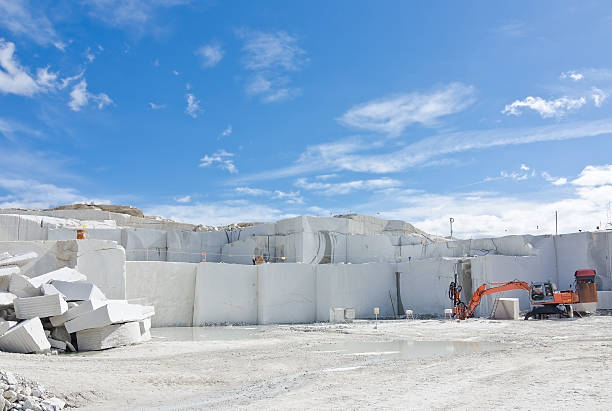Checking Out Granite Quarries in South Africa: A Comprehensive Guide
Checking Out Granite Quarries in South Africa: A Comprehensive Guide
Blog Article
Uncovering the Rich Background and Lasting Practices of Granite Quarrying
As we stand on the precipice of discovering the intricate tapestry of granite quarrying, a trip via time reveals not simply the physical act of removing stone yet likewise the social and historical value woven into the really fabric of this method. From the ancient beginnings that laid the foundation for contemporary quarrying strategies to the sustainable methods that are forming the future of this sector, each chisel mark on granite surfaces narrates waiting to be discovered (granite quarries in south africa). The heritage of granite quarrying stretches far past mere extraction; it is a testimony to human resourcefulness, resilience, and the enduring attraction of this marvelous stone
Ancient Beginnings of Granite Quarrying
Dating back to old worlds, the method of quarrying granite has actually been an integral part of human history and architectural innovation. The earliest evidence of granite quarrying dates back to ancient Egypt, where large pyramids and elaborate sculptures were crafted from this long lasting rock. The Egyptians used primitive devices to extract granite blocks from quarries, showcasing the value of this material in their huge buildings.
Relocating forward in background, the Greeks additionally made considerable payments to the quarrying of granite. The Greeks utilized granite in numerous architectural marvels, such as temples and statues, demonstrating their skill in shaping and sculpting this durable rock. The Romans better improved the strategies of quarrying granite, using innovative devices like knives and hammers to extract and form granite for their iconic structures.
Through the centuries, the practice of quarrying granite has evolved, with modern innovations boosting performance while preserving the ageless appeal of this natural stone - granite quarries in south africa. From old civilizations to modern contractors, the tradition of granite quarrying remains to shape our world
Evolution of Quarrying Techniques
The evolution of quarrying techniques has been noted by a continual development in the direction of better performance and accuracy in extracting granite. From the fundamental approaches utilized by our ancestors to the advanced technologies utilized in modern quarrying operations, the industry has actually gone through considerable improvements. Early quarrying methods included hands-on labor with fundamental devices such as knives, hammers, and wedges to extract granite blocks from the planet. As civilizations progressed, techniques like fire-setting and primitive explosives were presented to promote the removal procedure.
In even more recent times, the arrival of equipment changed the quarrying industry, enabling faster extraction rates and increased efficiency. Technologies such as ruby wire saws, high-pressure water jets, and pneumatic drills have actually become standard in contemporary quarries, permitting accurate cutting and lowered waste. Improvements in computer-controlled devices and 3D modeling have enhanced quarrying operations, leading to marginal environmental effect and improved sustainability techniques. As the demand for granite continues to climb, the development of quarrying techniques continues to be essential to conference sector requires efficiently and sustainably.
Social Significance of Granite
Granite holds a profound social importance across different worlds due to its long-lasting existence in architectural work of arts and revered monoliths. The cultural significance of granite prolongs beyond its physical features; it symbolizes resilience, security, and eternity, making it a symbol of sustaining heritages and customs.

Sustainable Practices in Quarrying
Amidst the abundant history of granite quarrying and its cultural value exists a growing focus on sustainable practices within the sector. As environmental awareness and concerns concerning source exhaustion have heightened globally, the quarrying sector has increasingly embraced lasting approaches to lessen its influence on the environment and surrounding neighborhoods.

Furthermore, improvement and rehabilitation of quarry sites post-extraction are important to lasting practices. By restoring quarried locations to an all-natural or useful state, such as developing wildlife habitats or entertainment spaces, quarriers can counter the ecological footprint of their procedures and add positively to the neighborhood ecosystem.
Legacy of Granite Quarrying
With a historical backdrop steeped in craftsmanship and commercial progression, what sustaining influence has granite quarrying left on the landscape of modern-day culture? The tradition of granite quarrying transcends mere extraction practices; it has formed building marvels, urban landscapes, and cultural heritage worldwide. The durable nature of granite has made it a recommended option for monoliths, structures, and facilities, standing as a testament to the ability and virtuosity of quarry employees you can find out more throughout generations.
Additionally, the economic impact of granite quarrying can not be neglected. The sector remains to offer work chances and drive local economies in areas where granite extraction is widespread. It has additionally spurred technical click here to read innovations in quarrying methods and tools, causing more reliable and sustainable techniques.
In regards to sustainability, the legacy of granite quarrying includes efforts to alleviate ecological impacts with recovery projects and accountable source monitoring. By balancing economic rate of interests with ecological stewardship, the industry strives to make sure that future generations can continue to take advantage of this enduring natural deposit.
Final Thought

Report this page